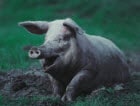[Source: Proc Natl Acad Sci USA, full text: (LINK). Abstract, edited.]
------
Pathogenesis and transmission of swine origin A(H3N2)v influenza viruses in ferrets
Melissa B. Pearce, Akila Jayaraman, Claudia Pappas, Jessica A. Belser, Hui Zeng, Kortney M. Gustin, Taronna R. Maines, Xiangjie Sun, Rahul Raman, Nancy J. Cox, Ram Sasisekharan, Jaqueline M. Katz, and Terrence M. Tumpey
Author Affiliations: <SUP>a</SUP>Influenza Division, Centers for Disease Control and Prevention, Atlanta, GA 30333; and <SUP>b</SUP>Harvard?MIT Division of Health Sciences and Technology, Singapore?MIT Alliance for Research and Technology, Department of Biological Engineering, Koch Institute for Integrative Cancer Research, Massachusetts Institute of Technology, Cambridge, MA 02139
Edited by Peter Palese, Mount Sinai School of Medicine, New York, NY, and approved January 18, 2012 (received for review December 5, 2011)
Abstract
Recent isolation of a novel swine-origin influenza A H3N2 variant virus [A(H3N2)v] from humans in the United States has raised concern over the pandemic potential of these viruses. Here, we analyzed the virulence, transmissibility, and receptor-binding preference of four A(H3N2)v influenza viruses isolated from humans in 2009, 2010, and 2011. High titers of infectious virus were detected in nasal turbinates and nasal wash samples of A(H3N2)v-inoculated ferrets. All four A(H3N2)v viruses possessed the capacity to spread efficiently between cohoused ferrets, and the 2010 and 2011 A(H3N2)v isolates transmitted efficiently to na?ve ferrets by respiratory droplets. A dose-dependent glycan array analysis of A(H3N2)v showed a predominant binding to α2-6?sialylated glycans, similar to human-adapted influenza A viruses. We further tested the viral replication efficiency of A(H3N2)v viruses in a relevant cell line, Calu-3, derived from human bronchial epithelium. The A(H3N2)v viruses replicated in Calu-3 cells to significantly higher titers compared with five common seasonal H3N2 influenza viruses. These findings suggest that A(H3N2)v viruses have the capacity for efficient replication and transmission in mammals and underscore the need for continued public health surveillance.
Footnotes
<SUP>1</SUP>To whom correspondence should be addressed. E-mail: tft9@cdc.gov.
Author contributions: M.B.P., C.P., H.Z., T.R.M., R.R., N.J.C., R.S., J.M.K., and T.M.T. designed research; M.B.P., A.J., C.P., J.A.B., H.Z., K.M.G., T.R.M., X.S., and T.M.T. performed research; A.J., H.Z., R.R., and R.S. contributed new reagents/analytic tools; M.B.P., A.J., C.P., J.A.B., H.Z., K.M.G., T.R.M., X.S., R.R., N.J.C., R.S., J.M.K., and T.M.T. analyzed data; and M.B.P., C.P., J.A.B., T.R.M., R.R., N.J.C., R.S., J.M.K., and T.M.T. wrote the paper.
The authors declare no conflict of interest.
This article is a PNAS Direct Submission.
This article contains supporting information online at www.pnas.org/lookup/suppl/doi:10.1073/pnas.1119945109/-/DCSupplemental.
-Melissa B. Pearce, Akila Jayaraman, Claudia Pappas, Jessica A. Belser, Hui Zeng, Kortney M. Gustin, Taronna R. Maines, Xiangjie Sun, Rahul Raman, Nancy J. Cox, Ram Sasisekharan, Jaqueline M. Katz, and Terrence M. Tumpey
Author Affiliations: <SUP>a</SUP>Influenza Division, Centers for Disease Control and Prevention, Atlanta, GA 30333; and <SUP>b</SUP>Harvard?MIT Division of Health Sciences and Technology, Singapore?MIT Alliance for Research and Technology, Department of Biological Engineering, Koch Institute for Integrative Cancer Research, Massachusetts Institute of Technology, Cambridge, MA 02139
Edited by Peter Palese, Mount Sinai School of Medicine, New York, NY, and approved January 18, 2012 (received for review December 5, 2011)
Abstract
Recent isolation of a novel swine-origin influenza A H3N2 variant virus [A(H3N2)v] from humans in the United States has raised concern over the pandemic potential of these viruses. Here, we analyzed the virulence, transmissibility, and receptor-binding preference of four A(H3N2)v influenza viruses isolated from humans in 2009, 2010, and 2011. High titers of infectious virus were detected in nasal turbinates and nasal wash samples of A(H3N2)v-inoculated ferrets. All four A(H3N2)v viruses possessed the capacity to spread efficiently between cohoused ferrets, and the 2010 and 2011 A(H3N2)v isolates transmitted efficiently to na?ve ferrets by respiratory droplets. A dose-dependent glycan array analysis of A(H3N2)v showed a predominant binding to α2-6?sialylated glycans, similar to human-adapted influenza A viruses. We further tested the viral replication efficiency of A(H3N2)v viruses in a relevant cell line, Calu-3, derived from human bronchial epithelium. The A(H3N2)v viruses replicated in Calu-3 cells to significantly higher titers compared with five common seasonal H3N2 influenza viruses. These findings suggest that A(H3N2)v viruses have the capacity for efficient replication and transmission in mammals and underscore the need for continued public health surveillance.
Footnotes
<SUP>1</SUP>To whom correspondence should be addressed. E-mail: tft9@cdc.gov.
Author contributions: M.B.P., C.P., H.Z., T.R.M., R.R., N.J.C., R.S., J.M.K., and T.M.T. designed research; M.B.P., A.J., C.P., J.A.B., H.Z., K.M.G., T.R.M., X.S., and T.M.T. performed research; A.J., H.Z., R.R., and R.S. contributed new reagents/analytic tools; M.B.P., A.J., C.P., J.A.B., H.Z., K.M.G., T.R.M., X.S., R.R., N.J.C., R.S., J.M.K., and T.M.T. analyzed data; and M.B.P., C.P., J.A.B., T.R.M., R.R., N.J.C., R.S., J.M.K., and T.M.T. wrote the paper.
The authors declare no conflict of interest.
This article is a PNAS Direct Submission.
This article contains supporting information online at www.pnas.org/lookup/suppl/doi:10.1073/pnas.1119945109/-/DCSupplemental.
------

Comment